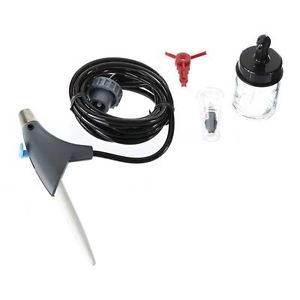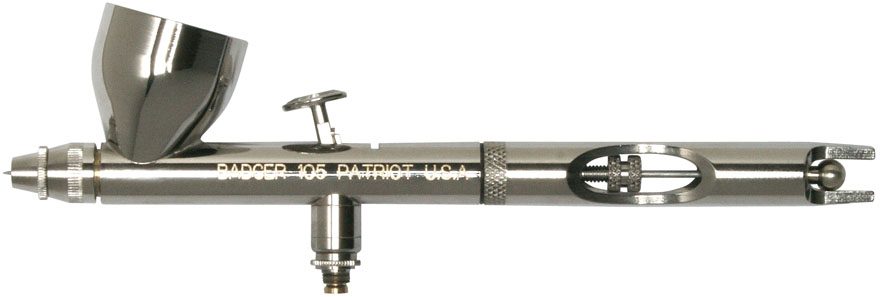If you’ve been a participant on any scale model forum- and I mean ANY of them- you’ve seen topics basically asking “what is the best airbrush?” Inevitably, users will offer answers about this brand, that brand, this needle size, that needle size. The discussion often degenerates into something that looks like a childhood playground argument, with charges of being a “poopy head” or some similar characterization.
Eventually, a few people will come along with some news that tends to make most folks step back and say “Yeah, that’s true.” And the discussion ends. That news?
It’s not the airbrush.
When I first returned to scale modeling in 2006, I was brush painting my models. In a most horrible fashion. Yet I’d see these wonderful works of painting skills on the model forums, and I’d ask “how did you do that?” Simple, my boy- buy an airbrush! Of course, the next question would be, “Which one?” After a lively discussion, and several charges of poopy-headedness, I’d come to the conclusion that there was no good answer.
What I did notice was most airbrushes were expensive, at least by my definition. (Anything over $20 is expensive by my definition….) And then one day I went to the Walmart….

I found a cheap, double action airbrush. Cheap being about $30. (So yes…. a bit expensive in my book…) The airbrush was called the Aztek 370.
Of course, the one airbrush most everyone poo-poo’d was the Aztek line. Awful, I was told. Cheap junk. And to be honest, the 370 did look cheap. But I thought it was worth a try. A kind friend gave me a nice hobby compressor, and away I went.
Most folks who start into airbrushing go in with high expectations, and on their first attempt, are usually sorely disappointed. And I was no exception.
But I also don’t give up on problems like that easily. So I started reading, and experimenting. And the more I worked with it, the better results I achieved. At some point, people actually started complementing me on my work. And they’d always ask ‘what airbrush did you use?” And I’d smile and say “An Aztek 370.” And they’d call me a poopy head and run away. 🙂
So what’s the moral of this long, drawn out, story?
It’s not the airbrush.
Certainly, a really cheap airbrush won’t give the best results. And by cheap I don’t mean money, but rather in its design and construction. But what few modelers want to admit, when the topic of airbrushing comes up, is that factors external to the airbrush make far more of a difference than the price of an airbrush, and the size of its needle.
So before you decide on an airbrush, here are some things to know about airbrushing that have little to do with the airbrush itself.
Air Pressure
One of the two biggest breakthrough discoveries for me was understanding how the air pressure affects the results. A good regulator will help your airbrushing out immensely. And there is no “correct” air pressure. Some folks shoot all their paint at 8-12 psi, others 15-18, other higher than that. In general, when you want to cover large areas, higher pressure is appropriate. Doing finer detail usually needs lower air pressure.
Air pressure that is too high can cause bad over-spray, while too low may result in splattering. And there is a relationship between air pressure and the distance you hold the brush from the model too. High air pressure close up may cause such air disturbance that it fouls things up.
The takeaway is to experiment with a variety of air pressures in a variety of conditions with the paints you use. Even the type of paint you use can perform differently at certain air pressures than another brand. And going hand in hand with air pressure was the second big thing I discovered, which was….
Thinning
I struggled and struggled with airbrushing at first. And folks would always suggest I check if it was thinned properly. A few suggested thinning it to the consistency of 2% milk. I thought “what are you talking about- what does milk have to do with it?” I finally had a light go on and I decided to actually put some milk in my airbrush- the 2% stuff.
And then it all made sense. My paint had been too thick. In fact, way too thick. Though I thinned it an amount I thought was enough, and to my eye it looked thin, it wasn’t enough.
Of course, after telling folks this, the next question- and it’s a logical one- is “so how much do you thin it?” The best answer I can give is- it depends.
It depends on what you’re trying to accomplish, basically. If it is wide coverage of an area, the paint may not need as much thinning as paint being used for fine lines or detailing. If it needs to be slightly translucent, it may require a lot more thinning. (Skim milk!)
It’s hard even say a good percentage. The best I can tell you, from my own painting, which is mostly Tamiya acrylics, is to start at about 50/50 paint and thinner. And then adjust from there. How do you know how much to adjust? Well my friend, that simply requires…
Practice
This is the one that you just can’t get around. You might be able to get by with some odd air pressure settings, or some thinning that is not quite up to snuff. But if you want to airbrush well– it takes practice. A lot of folks recommend practicing on cardboard, plastic milk jugs and other material like that. And that does have its place.
But the best way you can get good at airbrushing a scale model is to build a scale model and airbrush it. Plain and simple. Practice covering large areas, small areas, making squiggly lines, shading, fading and everything else you can think of. Sitting and planning and researching a build for six months will not replicate building models for six months and airbrushing them.
Eventually, you get to a point that someone can put any airbrush in your hand, and aside from minor feel differences, etc., you’ll realize that it’s not the airbrush.
It’s you.
Now, if you’ve read this far, and you’re still thinking “yeah, but I don’t have an airbrush, and I want to get one, so what do you recommend?”

I’ll only recommend one: Badger Air Brush Company’s Patriot Model 105. There are other brands and models that would do a great job, certainly. But this is the one I use. And every technique anyone has suggested or I have thought up has worked fine with it. Wide area, fine lines, shading, fading. I can do it all with this airbrush. Because it’s a good airbrush.
(If you’d like to read a review I published on the Badger Patriot, follow this link to AgapeModels.com)
But more than that- I’ve learned to understand that air pressure, thinning and practice make far more of a difference than the piece of equipment.
So even if you choose another airbrush, I can guarantee you that if you don’t pay attention to the fundamentals, and then put them to practice, there isn’t an airbrush made that will make up for it. No matter how much you pay, or how many opinions you get about brands and models.


Leave a Reply